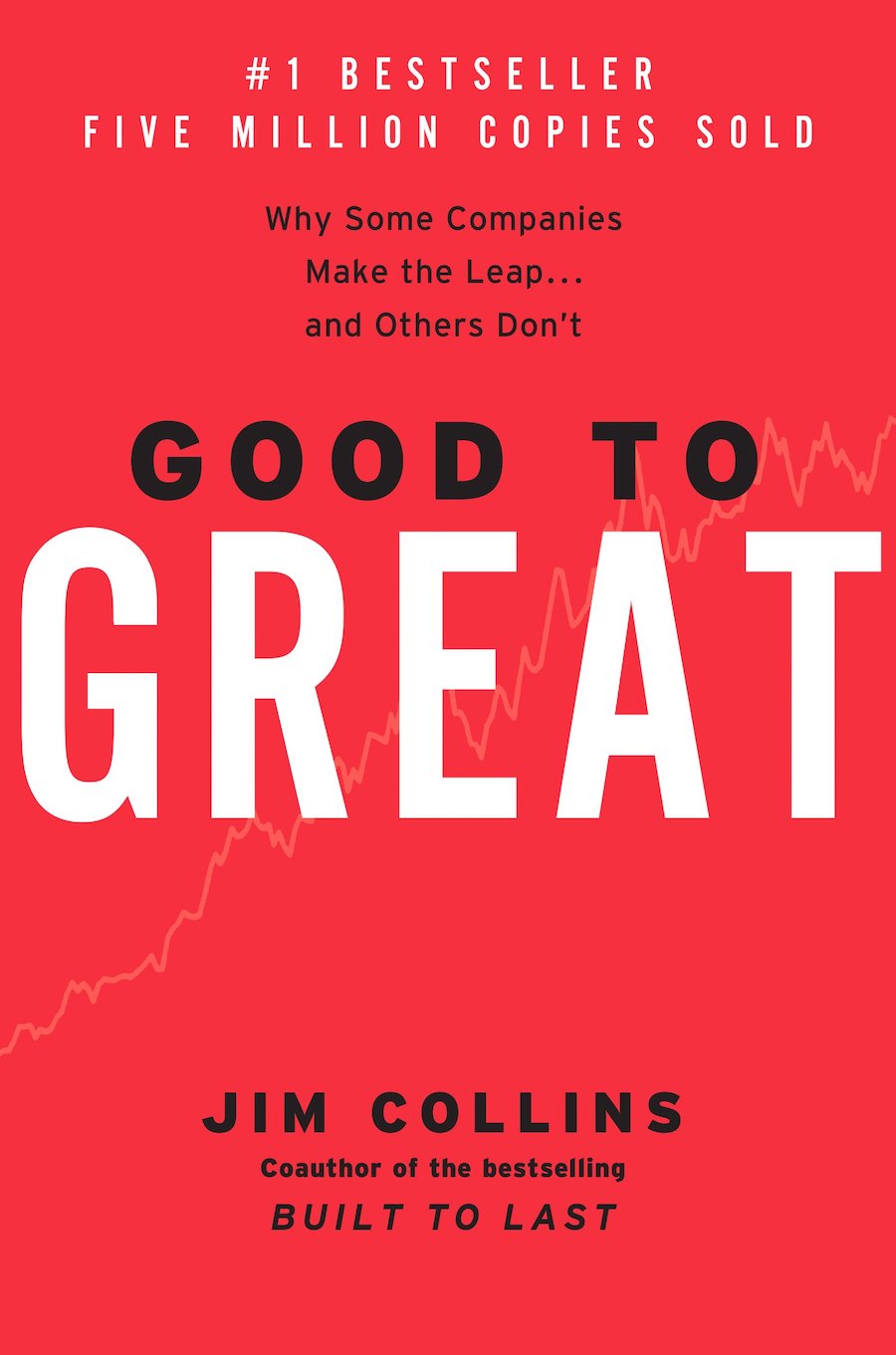Good to Great: Why Some Companies Make the Leap and Others Don't
Description:
The Challenge:
Built to Last, the defining management study of the nineties, showed how great companies triumph over time and how long-term sustained performance can be engineered into the DNA of an enterprise from the very beginning.
But what about the company that is not born with great DNA? How can good companies, mediocre companies, even bad companies achieve enduring greatness?
The Study:
For years, this question preyed on the mind of Jim Collins. Are there companies that defy gravity and convert long-term mediocrity or worse into long-term superiority? And if so, what are the universal distinguishing characteristics that cause a company to go from good to great?
The Standards:
Using tough benchmarks, Collins and his research team identified a set of elite companies that made the leap to great results and sustained those results for at least fifteen years. How great? After the leap, the good-to-great companies generated cumulative stock returns that beat the general stock market by an average of seven times in fifteen years, better than twice the results delivered by a composite index of the world’s greatest companies, including Coca-Cola, Intel, General Electric, and Merck.
The Comparisons:
The research team contrasted the good-to-great companies with a carefully selected set of comparison companies that failed to make the leap from good to great. What was different? Why did one set of companies become truly great performers while the other set remained only good?
Over five years, the team analyzed the histories of all twenty-eight companies in the study. After sifting through mountains of data and thousands of pages of interviews, Collins and his crew discovered the key determinants of greatness — why some companies make the leap and others don’t.
The Findings:
The findings of the Good to Great study will surprise many readers and shed light on virtually every area of management strategy and practice. The findings include:
- Level 5 Leaders: The research team was shocked to discover the type of leadership required to achieve greatness.
- The Hedgehog Concept: (Simplicity within the Three Circles): To go from good to great requires transcending the curse of competence.
- A Culture of Discipline: When you combine a culture of discipline with an ethic of entrepreneurship, you get the magical alchemy of great results. Technology Accelerators: Good-to-great companies think differently about the role of technology.
- The Flywheel and the Doom Loop: Those who launch radical change programs and wrenching restructurings will almost certainly fail to make the leap.
“Some of the key concepts discerned in the study,” comments Jim Collins, “fly in the face of our modern business culture and will, quite frankly, upset some people.”
Perhaps, but who can afford to ignore these findings?
Editorial Reviews:
Amazon.com Review
Five years ago, Jim Collins asked the question, “Can a good company become a great company and if so, how?” In Good to Great Collins, the author of Built to Last, concludes that it is possible, but finds there are no silver bullets. Collins and his team of researchers began their quest by sorting through a list of 1,435 companies, looking for those that made substantial improvements in their performance over time. They finally settled on 11–including Fannie Mae, Gillette, Walgreens, and Wells Fargo–and discovered common traits that challenged many of the conventional notions of corporate success. Making the transition from good to great doesn’t require a high-profile CEO, the latest technology, innovative change management, or even a fine-tuned business strategy. At the heart of those rare and truly great companies was a corporate culture that rigorously found and promoted disciplined people to think and act in a disciplined manner. Peppered with dozens of stories and examples from the great and not so great, the book offers a well-reasoned road map to excellence that any organization would do well to consider. Like Built to Last, Good to Great is one of those books that managers and CEOs will be reading and rereading for years to come. —Harry C. Edwards
From Publishers Weekly
In what Collins terms a prequel to the bestseller Built to Last he wrote with Jerry Porras, this worthwhile effort explores the way good organizations can be turned into ones that produce great, sustained results. To find the keys to greatness, Collins’s 21-person research team (at his management research firm) read and coded 6,000 articles, generated more than 2,000 pages of interview transcripts and created 384 megabytes of computer data in a five-year project. That Collins is able to distill the findings into a cogent, well-argued and instructive guide is a testament to his writing skills. After establishing a definition of a good-to-great transition that involves a 10-year fallow period followed by 15 years of increased profits, Collins’s crew combed through every company that has made the Fortune 500 (approximately 1,400) and found 11 that met their criteria, including Walgreens, Kimberly Clark and Circuit City. At the heart of the findings about these companies’ stellar successes is what Collins calls the Hedgehog Concept, a product or service that leads a company to outshine all worldwide competitors, that drives a company’s economic engine and that a company is passionate about. While the companies that achieved greatness were all in different industries, each engaged in versions of Collins’s strategies. While some of the overall findings are counterintuitive (e.g., the most effective leaders are humble and strong-willed rather than outgoing), many of Collins’s perspectives on running a business are amazingly simple and commonsense. This is not to suggest, however, that executives at all levels wouldn’t benefit from reading this book; after all, only 11 companies managed to figure out how to change their B grade to an A on their own.
Copyright 2001 Cahners Business Information, Inc.
About the Author:
Jim Collins is a student and teacher of what makes great companies tick, and a Socratic advisor to leaders in the business and social sectors. Having invested more than a quarter century in rigorous research, he has authored or coauthored a series of books that have sold in total more than 10 million copies worldwide. They include Good to Great, the #1 bestseller, which examines why some companies make the leap and others don’t; the enduring classic Built to Last, which discovers why some companies remain visionary for generations; How the Mighty Fall, which delves into how once-great companies can self-destruct; and Great by Choice, which uncovers the leadership behaviors for thriving in chaos and uncertainty. Jim has also published two monographs that extend the ideas in his primary books: Good to Great and the Social Sectors and Turning the Flywheel.
His most recent publication is BE 2.0 (Beyond Entrepreneurship 2.0), an ambitious upgrade of his very first book; it returns Jim to his original focus on small, entrepreneurial companies and honors his coauthor and mentor Bill Lazier.
Driven by a relentless curiosity, Jim began his research and teaching career on the faculty at the Stanford Graduate School of Business, where he received the Distinguished Teaching Award in 1992. In 1995, he founded a management laboratory in Boulder, Colorado, where he conducts research and engages with CEOs and senior-leadership teams.
In addition to his work in the business sector, Jim has a passion for learning and teaching in the social sectors, including education, healthcare, government, faith-based organizations, social ventures, and cause-driven nonprofits. In 2012 and 2013, he had the honor to serve a two-year appointment as the Class of 1951 Chair for the Study of Leadership at the United States Military Academy at West Point.
Jim holds a bachelor’s degree in mathematical sciences and an MBA from Stanford University, and honorary doctoral degrees from the University of Colorado and the Peter F. Drucker Graduate School of Management at Claremont Graduate University. In 2017, Forbes selected Jim as one of the 100 Greatest Living Business Minds.









